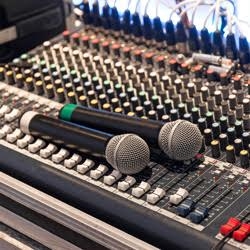
Shure is approaching the transition on many fronts. Brunner states that these efforts include improving spectral efficiency, advocating for frequency bands that pro users can migrate to and then developing the necessary technology and products, and creating reliable wireless to meet the needs of unlicensed, semi-professional users.
The company has also been exploring the VHF band while expanding the ULX-D line into the 900 MHz and lower UHF bands down to 470 MHz.
Digital transmission technologies such as the ULX-D operating in “high density mode” can allow more channels to share a given band of frequency, with Brunner adding that “antenna technology has improved, enabling VHF as a viable option for professional use.”
From Sennheiser’s perspective, two critical aspects of future wireless designs are tuning flexibility and spectral efficiency. The ability of receivers and transmitters to operate over a wide band of frequencies allows users to avoid areas where other licensed or unlicensed equipment may create interference, while still providing sufficient spectrum. Sennheiser also recently added the A1 band, which starts at 470 MHz.
Getting The Word Out
With a transition of this magnitude, reliable information along with advice and technical assistance from manufacturers is essential. Winkler has been heavily involved in a variety of educational and training efforts around the coming changes. Along with Tim Vear of Shure and Eric Reese of Sennheiser, he’s served as a co-instructor at SynAudCon’s “Making Wireless Work” educational seminars. He also notes that the company’s sales managers consult with customers to evaluate the frequency bands of their current wireless equipment, help them understand the auction process and how it is proceeding, and offer input on how they can adapt for the future.
Along with other educational outreach, Sennheiser has published white papers that detail the likely impact of the spectrum auction for wireless microphones, along with providing informed counsel to dealers and customers. The company has also instituted a “trade-in” incentive program on certain models for affected wireless.
Shure has been an active advocate as well, sending out press announcements that help keep the pro audio public informed, hosting phone conferences, providing insights and updates to dealers and customers, and participating in forums such as the “Current & Future State Of Wireless/RF In The U.S.” podcast currently available on ProSoundWeb. The company also began discontinuing products in the upper portion of the 600 MHz band in 2015, recommending that customers opt for lower UHF or unlicensed bands.
Making The Transition
As Brunner notes, “Until the auction is complete, we won’t know what the actual band plan is.” However, in distilling all of this the input, there are several actions wireless users can take to minimize the effects of the transition, including:
– Inventory current wireless equipment to see which ones are operating in soon-to-be-cleared bands, and predict future requirements such as how many channels, what mix of mics, IEM, and intercoms will be needed, and so on.
– Know the RF environment in the locations where they operate, and become familiar with likely future shifts and interference sources. Reference the FCC’s TV Query Broadcast Database and other information sources.
– Determine whether they qualify to become a licensed user of wireless microphones, and begin the licensing process. It’s likely that the manufacturers of the users’ wireless equipment can provide guidance.
– If a significant number of current channels will only operate in the 600 MHz band, team with those manufacturers to smooth the transition.
– When purchasing additional channels, get them in the lower UHF bands and supplement with VHF and the unlicensed 900 MHz and 2.4 GHz bands. For example, the Radio Active Designs UV-1G wireless intercom operates in the VHF band, Clear-Com’s Freespeak II operates at 1.9 and 2.4 GHz, and the RTS BTR-240 at 2.4 GHz. Wireless mics and IEMs suitable for semi-pro and pro applications are also widely available in these bands.
– Use available scanning tools and planning software to visualize the RF environment and efficiently place wireless into service. Many systems are complemented with management software that helps with RF planning, advancing shows, and monitoring systems during events.
– Finally, be prepared to share wireless and frequency coordination information with other operators in nearby venues, especially in high-density areas like Broadway’s Theatre District.
“The future is solid for licensed wireless users, yet may be tougher for smaller non-profit performing arts centers and others that aren’t eligible for licensing,” Ciaudelli concludes.
Knowing what’s coming will help in making the best of the situation while keeping productions running without interference.
Gary Parks is a writer who has worked in pro audio for more than 25 years, holding marketing and management positions with several leading manufacturers.
